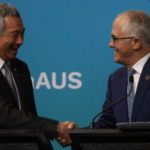Will Labor win a second term?

Addressing the first meeting of Labor’s new caucus, Anthony Albanese held out the prospect of “back-to-back premierships”. But a second-term in government isn’t a given, he implied – it is something Labor will have to earn. Does he really believe Labor might not be re-elected?
Not since 1931 has any government failed to win a second term. So predictable has the victory become that political commentators routinely refer to the “reluctance” of voters to despatch a government after just one term. Given the historical record, one journalist has even argued Albanese’s focus should be on a third term.
Predictably, Peter Dutton was having none of it. His plan, he told his troops, was to limit Labor to just one term. To anyone looking at the Coalition’s numbers, this may have sounded fanciful. Yet, some observed, this may not have been a bad election for the Coalition to lose.
Labor has often won office only to be buffeted by economic forces beyond its control – after 1929, obviously; but also after its 1972 and 2007 wins. With declining economic growth in the United States and China, perhaps 2022 will prove to be no different.
Governments seeking a second term tend to lose votes
What happens to electoral support for governments seeking a second term is rather different from what we might imagine if all we knew was that they almost always win.
Since the war, seven governments have sought a second term. Three were led by Labor prime ministers (Gough Whitlam, 1974; Bob Hawke, 1984; Julia Gillard, 2010), and four by Liberal prime ministers (Robert Menzies, 1951; Malcolm Fraser, 1977; John Howard, 1998; Malcolm Turnbull, 2016).
On every occasion, the government’s two-party vote went backwards. In the 1950s and in the 1970s and 1980s this loss of votes wasn’t particularly large: 0.3 percentage points (1951), 1.0 (1974), 0.9 (1977) and 1.4 (1984) – an average of 0.9. But since the late 1990s, the loss of votes has been greater: 4.6 percentage points (1998), 2.6 (2010) and 3.1 (2016) – an average of 3.4.
The contrast between the two periods is even sharper if we think of prime ministers rather than parties seeking second terms. In 2013, when Gillard sought a second term, Labor’s two-party vote declined by 3.6 points. In 2022, when Morrison sought a second term, the Coalition’s two-party vote declined by 3.3 points. In all the other elections, the prime minister seeking a second term was the same prime minister who had secured a first term.
Why might postwar governments have always been returned on their first attempt? Is it because the swings against them have been more muted at the end of their first term than at the end of their second or third terms?
For Labor, yes. Labor governments have shed 1.7 percentage points, on average, after their first term; after their second, the average figure is 4.0 points.
However, for the Coalition, the contrary is true. At the end of their first terms, Coalition governments have shed an average of 2.2 percentage points. But at the end of their second terms, having increased their vote on two occasions, their average loss has been just 0.7 points. And at the end of their third terms – again, having twice increased their vote – they have actually gained a point.
On this evidence, the idea that voters are reluctant to throw out first term governments is mistaken.
So why do most governments win a second term?
Governments fail to fall at the end of their first term because of the margins by which they are elected in the first place.
Elected in 1996 with a 40-seat majority, the Howard government hung on in 1998 despite a swing of 4.6 points that should have seen it lose. In 2010, Gillard survived because of the size of Rudd’s 2007 win, though she now headed a minority government. In 2016, Turnbull survived by the narrowest of majorities, saved by the size of Abbott’s win.

Malcolm Turnbull’s win in 2016 relied on the buffer established by his predecessor Tony Abbott’s big win at the previous election.
The idea that close results reflect voters’ “ambivalence” is a category mistake: electorates aren’t “ambivalent” even if some voters are. The view that close elections show that voters think neither side “deserves” to govern is another category mistake. Very likely, most voters think one side or the other deserves to govern. It’s just that those who think the Coalition deserves to govern are matched, more or less, by those who think Labor deserves to do so.
Can Labor get a second term?
If the swings endured by first term governments in 2010 or 2016 – or the swing endured by a first term Morrison government – are any guide, the chances of an Albanese government being returned as a majority government are low.
Although Labor won 51.9% of the two-party vote, it would take only small swings – 0.2 percentage points in Gilmore (New South Wales) and 0.8 in Lyons (Tasmania) – for it to lose its majority.
How many other seats could it afford to lose and still govern in minority? A two-party swing of 3.1 percentage points – the smallest swing suffered by any of the last three first-term governments – could see the government lose eight seats to the Coalition, leaving Labor with 69 seats and the Coalition with 66. A swing of 4.6 points – the biggest swing suffered by any of these three governments – could see it lose another four: Labor 65, the Coalition 70. Because the electoral pendulum is not a perfect predictor, these are estimates.
Were the Coalition to win back a few of the seats won narrowly by the “teal” independents, then Labor’s position would become even more precarious. It might be able to count on the four Greens plus Andrew Wilkie to claim the support of 70 MPs. But if the Coalition won 72 or 73 seats and a bigger vote share (primary and two-party) than Labor, it might be better placed than Labor to strike an agreement with the remaining independents. Where Labor would need almost all eight or nine independents to form a minority government, the Coalition might need only three or four.
Other possibilities could weaken Labor’s position even further: a loss of a seat or two to the teals or to the Greens; or the Coalition’s winning back a seat or two from the Greens. If either of these things happened, Labor’s hold on government might be beyond saving.
The last one-term Labor government was a casualty of the Great Depression. Having secured 48.8% of the first preference vote and 46 of the 75 seats in the House in 1929, Labor managed only 37.7% of the vote and 18 seats in 1931 – even if we include the breakaway party, Lang Labor.
Will economic circumstances come to the aid of the non-Labor parties again?
This article was published by The Conversation.
Murray Goot is an Emeritus Professor of Politics and International Relations at Macquarie University. He was written widely on Australian politics, electoral behaviour, public opinion, and the media.













